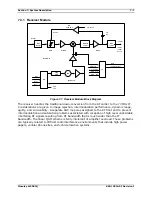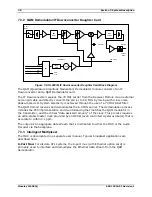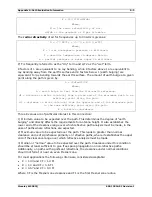
Appendix A: Path Evaluation Information
A-3
Moseley SL9003Q
602-12016-01 Revision J
K = 157/(157+dN/dh)
Where,
N is the radio refractivity of air.
dN/dh is the gradient of N per kilometer.
The
radio refractivity
of air for frequencies up to 30 GHz is given as:
N = (77.6P/T) + (3.73 x 105 )(e/T2)
Where,
P = total atmospheric pressure in millibars.
T = absolute temperature in degrees Kelvin.
e = partial pressure of water vapor in millibars.
P/T is frequently referred to as the "dry" term and e/T2 as the "wet" term.
K factors of 1 are equivalent to no ray bending, while K factors above 1 are equivalent to
ray bending away from the earth's surface and K factors below 1 (earth bulging) are
equivalent to ray bending towards the earth's surface. The amount of earth bulge at a given
point along the path is given by:
h = (2d1xd2)/3K
Where,
h = earth bulge in feet from the flat-earth reference.
d1 = distance in miles (statute) from a given end of the microwave path to an
arbitrary point along the path.
d2 = distance in miles (statute) from the opposite end of the microwave path
to the same arbitrary point along the path.
K = K-factor considered.
Three K values are of particular interest in this connection:
1) Minimum value to be expected over the path. This determines the degree of "earth
bulging" and directly affects the requirements for antenna height. It also establishes the
lower end of the clearance range over which reflective path analysis must be made, in the
case of paths where reflections are expected.
2) Maximum value to be expected over the path. This leads to greater than normal
clearance and is of significance primarily on reflective paths, where it establishes the upper
end of the clearance range over which reflective analysis must be made.
3) Median or "normal" value to be expected over the path. Clearance under this condition
should be at least sufficient to give free space propagation on non-reflective paths.
Additionally, on paths with significant reflections, the clearance under normal conditions
should not fall at or near an even Fresnel zone.
For most applications the following criteria are considered acceptable:
•
K = 1.33 and CF = 1.0 F1
•
K = 1.0 and CF = 0.6 F1
•
K = 0.67 and CF = 0.3 F1
Where CF is the Fresnel zone clearance and F1 is the first Fresnel zone radius.
Summary of Contents for Starlink SL9003Q
Page 86: ...5 22 Section 5 Module Configuration Moseley SL9003Q 602 12016 01 Revision J ...
Page 90: ...6 4 Section 6 Customer Service Moseley SL9003Q 602 12016 01 Revision J ...
Page 110: ...A 10 Appendix A Path Evaluation Information Moseley SL9003Q 602 12016 01 Revision J ...
Page 118: ...D 2 Appendix D Microvolt dBm Watt Conversion 50 ohms Moseley SL9003Q 602 12016 01 Revision J ...
















































